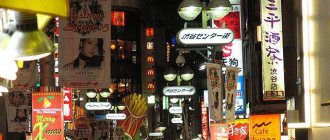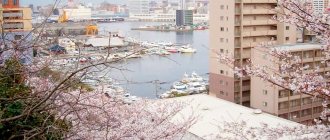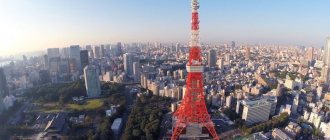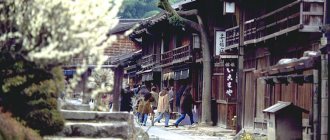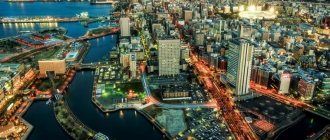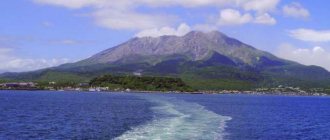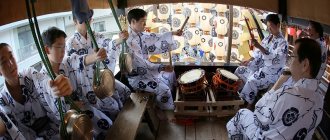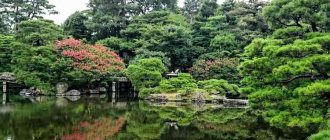Kokusai Street
Kokusai Street is the name of a popular shopping street in Naha City, Okinawa Province.
After World War II, the area grew rapidly. The street is about 1.6 kilometers long and is filled with supermarkets, souvenir shops and food establishments. Everywhere there are a lot of different restaurants offering delicacies originally from Okinawa - soba, as well as taverns, restaurants, steakhouses and so on.
Here you can also buy a wide variety of souvenirs: sweets from Okinawa - Sata Andagi, something like a donut, and pineapple sweets, snacks and drinks (in particular Awamori, a strong drink that is made in Okinawa), pottery, say, Yachimun, which is made using insole from Ryukyu. Many shops are open late, until 23:00, and they are always crowded. Kokusai Street is a real tourist attraction in Naha.
Nami No Ue Shrine and the beach of the same name
One of the main temples in Naha and Okinawa, guarding ships sailing to the port and very beloved by the residents.
Like many things in Okinawa, it was destroyed during World War II and rebuilt.
Since I came here for the New Year holidays, it was quite crowded at that time, because... At this time, Hatsumode (the first visit to the temple in the New Year) takes place.
Directly from the temple you can get to the beach, or you can go to something like a park with an observation deck, where birds scream, flowers smell and butterflies fly.
And yes, there is a highway near the beach, but this does not prevent the water from being clean!
Shikina-en
Shikina-en is located in Naha, Okinawa Prefecture, and is the largest residence of the Ryukyu royal family, which existed for 450 years, from 1429 to 1879. Its main purpose was to relax for members of the royal family and receive foreign ambassadors. The garden was built at the end of the 18th century and destroyed during the Second World War. In 1975, restoration of the garden began, which lasted 20 years.
The garden's composition incorporates Japanese and Chinese motifs into the local Okinawan style, as well as landscapes borrowed from the Ryukyu Royal Palace and a flower garden. There is a pond in the garden, with an arched bridge across it to the island in the middle of the pond. It leads to a hexagonal gazebo in the Chinese style called "rokkakudo". Using Japanese gardening art, the pond was shaped into the cursive character for "heart" (心). This is a wonderful strolling garden where you can stroll peacefully and enjoy the surrounding scenery after a busy tour of Naha.
Since 2000, Shikina-en Garden has been included in the World Cultural Heritage List and is protected by UNESCO.
What to try deliciously in Okinawa and Naha
It is believed that one of the factors due to which Okinawa has the highest percentage of people in Japan living to be 100 years old is healthy food. The islands offer a distinctive Ryukyu cuisine that combines Japanese and Chinese cooking with many tropical ingredients and extensive use of pork and fresh seafood. In the diet of the so-called “Ryukyu cuisine” there are two types of dishes: “palace cuisine”, which only the residents of Shuri Castle could be satisfied with, and the universally accessible “folk cuisine”. “Palace cuisine” was formed under the influence of China and Japan. “Folk cuisine” reflects the modest way of life of the people: without luxury, but healthy and nutritious. Old people in Okinawa use the Okinawan dialect to talk about food by saying “kusuimun” (medicine) or “nuchigusui” (medicine of life). Since ancient times, Okinawa has believed that food can heal as well as medicine. Okinawan dishes use culinary recipes using herbs and seaweeds with medicinal or health benefits.
So, the five main participants in the Okinawan meal: bitter melon - goya, bean curd tofu, soba noodles, sweet potatoes Imo and pork cooked in a special way (it is boiled until it becomes jelly-like and the fat and other harmful elements evaporate).
Meat and fish broth soup with pieces of pork and fish, green onions, pickled red ginger and koregusu (awamori pickled chili peppers)
Among the most common dishes are: Okinawa soba - thick wheat noodles with pieces of pork and chanpuru (which means 2 or more mixed together) - a mixture of vegetables, tofu and pork fried in a thick stew on a hot frying pan. These dishes can be served in different ways depending on the main ingredient. It is worth trying chanpura with pumpkin - nabera , bitter watermelon - goya , wheat gluten - fu , wheat noodles - somen . Tempura here is also prepared in a special way: the dough is denser and moister. And Okinawa soba is such a favorite dish that October 17 is considered Okinawa Soba Day.
Almost every food is used in local cuisine
I am part of the pork carcass: blood is added when frying vegetables for tii-iriti , and nakami soup . Goat stew - yagijiru - is a village dish especially popular in the Miyako Islands; There you can also try irabujira , a stewed sea snake. Local seafood cuisine includes dishes from irabutya - parrot fish, miibai - sea bass, ika - squid and its ink. Among vegetarian dishes, it is worth noting a wide variety of tofu varieties, including soft - jimamadofu made from peanuts.
The most exquisite food of the Ryukyu is tunda-bun , a balanced meal served in small portions, like kaiseki ryori on the main islands of Japan. (I tried Kaiseki Ryori in Tokushima, on Shikkoku - very tasty and more than educational!) Many dishes, of course, are not for everyone, just like Japanese cuisine in general, for example, tofuyo - tofu fermented in awamori (similar to blue cheese).
Awamori is best drunk from special ryukyu glasses.
Awamori is a rice liquor produced in Okinawa, like wine, which only improves with time. The alcohol content in it reaches 60%. To make it, a Thai variety of rice is used and after 3 or more years of aging it is called kusu - an old liquor and acquires a sweet taste.
What else can you try? butamaruyaki is very tasty with Orion beer. And absolutely magical and unusual are the “sea grapes” umibudo , which are served with vinegar, sugar and soy sauce.
Here: https://1oki.com/3043 details about umibudo, but in Japanese.
Where to eat in Nakha
Naha undoubtedly has the largest selection of restaurants in Okinawa, serving the best of Ryukyu Ryori and international cuisine. The best restaurants, bars and izakayas can be found along Kokusai-dori, especially in the Kumoji and Makishi areas, north of the Palette Kumoji shopping mall. Palette Kumoji itself has many restaurants on the 9th floor, but they are not as good as the Mitsukoshi department store.
What you need to know: the most expensive establishments are those whose sign shows a cook with one or two knives. These are restaurants with a cooking show, that is, guests sit around a huge stove and the chef prepares the food in front of you while juggling salt and pepper shakers with knives. On average $100 per person, especially if with awamori. More modest establishments are restaurants with traditional Okinawan cuisine - $30-50 per person. There are almost no restaurants serving Japanese cuisine. Sushi can be enjoyed in the restaurant, which is located on the ground floor of the RUBO hypermarket. For those who like to save money, the following options are possible - there is also a great selection of ready-made food. Everything is very fresh and very tasty - for pennies. In the center of Kokusai dori there is a restaurant (I forgot its name, but it’s easy to recognize by its logo - a pig in a chef’s hat) where upon entering you pay a fixed (small) amount, collect raw meat from various creatures and fry it all on a special grill, which is located in center of the table allocated to you. There, salads, miso, drinks (non-alcoholic) and desserts are all included in the original price. Another cool place is Nigosen in the Shintoshin area of Naha. Cheap and tasty. (Information from the article “Guide to Okinawa” by Bogdan Kurilko)
On the Gurunavi - Japan Restaurant Guide website (https://r.gnavi.co.jp/lang/en/pref47/) you can see addresses, the cost of lunches and dinners, or search for a restaurant that serves the desired dish.
Another list of Okinawan cuisine restaurants - Ryukyu Cuisine
And a few more budget recommendations, if you come across them along the way, you should pay attention to these restaurants:
Bindunchi - Bl Koramu Biru, 1-4-1 Matsuo, Kokusai-dori - This inexpensive basement restaurant is one of the best places to try Okinawan cuisine. Awamori ice cream set menu costs 1,000 yen.
Dai-Ichi Kosetsu Ichiba - several small restaurants above the food market behind Ichiba-dori. You can order a dish from the menu or choose your favorite fish from the market downstairs, which will be cooked and delivered to your table. They serve inexpensive sashimi here. Every day from 10.00 to 20.00.
Naha Municipal Tsuboya Pottery Museum
This is an old building with a stone floor, conveying the atmosphere of old Okinawa. Here you can see a variety of pottery from the Jomon period to the present day and learn about pottery techniques.
The art of pottery in Okinawa is called "yachimun". In the past, pottery was made in every province of Okinawa, but in 1682 the King of the Ryukyu ordered the establishment of a pottery workshop in Tsuboya. Tsuboi pottery uses clay and glaze.
On the first and second floors of the museum you can see works of people recognized as National Treasures of Japan. The Nishinu pottery kiln is located in the courtyard of the building.
Transport
Naha is Okinawa's most important transportation hub. There is an international airport and seaport here, connecting the city with the rest of the islands of the Ryukyu archipelago and the whole of Japan. Intracity transport is represented by bus service and a monorail, which has 15 stations and is the main transport system of the city.
Sakaemachi Market
Sakamachi Market is located in Naha City. It was founded in 1955 during the country's reconstruction after the war, and still retains the atmosphere of the Showa period (1926-1989). The market itself has about 150 shops that sell various products - vegetables, salads and side dishes, everyday goods and much more. The market has been adapted to modern conditions and is visited daily by local residents. During the day there are always a lot of people there, and in the evening people who like to eat delicious food at local establishments come here. The market has many Okinawa-style restaurants and bars, yakitoria and coffee shops where you can sample local specialties.
Iriomote Island
Iriomote is famous for its mangrove swamps, jungles and rare wildlife such as the Iriomote wild cat. The island is part of Iriomote National Park, Japan's southernmost national park.
Interesting places on the island:
Jungle boat tours are offered along the island's two longest rivers, the Urachigawa and Nakamagawa. A walk along the Urachigawa River can be combined with a two-hour trek through the jungle to two beautiful waterfalls. You can also rent a canoe and explore the river or take part in canoe tours as a passenger. The island has a variety of hiking trails, the most stimulating of which is the 20-kilometer cross-island route, which also offers excellent snorkeling and diving opportunities.
How to get there?
Iriomote is connected to Ishigaki Island by high-speed boats. It takes approximately 40 minutes for a one way trip. There are also boats from Port Ishigaki to Funaura and nearby Uehara in the north of Iriomote and Ohara in the south of the island. Iriomote Island has only one main road, running along the coast from Shirahama through Urauchigawa and Funahara to Ohara. The public bus operates five trips a day between Shirahama and Funahara and three trips a day between Funahara and Ohara. The journey takes about 50 minutes. In addition to the public buses, there are free shuttle buses operated by the various dive and tour companies on the island. Finally, it is also possible to rent a car from one of several outlets near the pier. At low tide, you can travel between the islands of Iriomote and Yufu by oxcart. Such a journey is like being rocked in a cradle. Yufu Island has been completely transformed into a subtropical botanical garden.
Naha City Traditional Arts and Crafts Center
The museum is located in Naha, Okinawa Prefecture. Here you can see crafts such as tsuboyaki (pottery), bingata, glass, lacquerware, etc.
In the exhibition hall you can see historical artifacts, works of people recognized as National Treasures of Japan. On the monitors you can see the process of making pottery. There is also a room where craftsmen work right before your eyes. You too can take part in the process. You can make Okinawan lion statues, tablecloths, etc. In the souvenir shop, you can purchase products made in the center. These souvenirs combine new trends and traditional Okinawan culture. The Crafts Center is another traditional attraction in Naha.
Guide: Nagoya Attractions
Notes
- Dictionary of geographical names of foreign countries / resp. ed. A. M. Komkov. — 3rd ed., revised. and additional - M.: Nedra, 1986. - P. 331.
- The area is indicated according to the website [www.gsi.go.jp/KOKUJYOHO/MENCHO-title.htm Geospatial Information Authority of Japan
] (Japanese) taking into account [www.gsi.go.jp/KOKUJYOHO/MENCHO/201110/opening. htm changes], published October 1, 2011. - [www.pref.okinawa.jp/toukeika/estimates/estidata.html 沖縄県の推計人口] (Japanese). Okinawa Prefectural Government (August 29, 2014). — Population of Okinawa Prefecture. Retrieved August 29, 2014.
- The number is indicated according to [www.e-stat.go.jp/SG1/estat/GL02100104.do?tocd=00200521 Japanese census data] of 1980, 1985, 1990, 1995, 2000 and 2005.
